In the global hair market, there are way too many hair vendors, each option has its own perks and drawbacks. Therefore, it is almost inevitable for hair buyers, especially for first-time business owners, to feel overwhelmed by the enormous number of hair suppliers in the market. Among such a diverse range of options, Vietnam and India are two of the most prominent choices, with their distinctive product lines and price ranges.
Despite some minor similarities, this article can still provide readers with the differences between Vietnamese hair vs Indian hair, and assist young, ambitious hair business owners to navigate through the complex hair market and pick out the most suitable vendors for their business.

1. What is Vietnamese hair?
Vietnamese hair is strictly collected from women of minorities residing in the Northern regions of Vietnam – the main abundant source of high-quality hair in this country. One of the reasons is for their traditions of keeping and preserving their hair at its natural state.
In fact, due to the region’s developing economy, the female population rarely gets access to the complementary beauty demands or the globalized hair styling trends like dyeing or bleaching,… Therefore, they could still preserve their hair at its pristine state, with no prior harmful processes. Another reason is the region’s low income rate, leading to a stable supply of hair, as many women proceed to sell their high-quality, premium hair in exchange for financial gains. In fact, in Vietnam, many women of minorities often have the habit of not cutting their hair, leaving their hair to grow to an impressive length, leading to a large supply for rare hair lengths such as 36” or 40”.
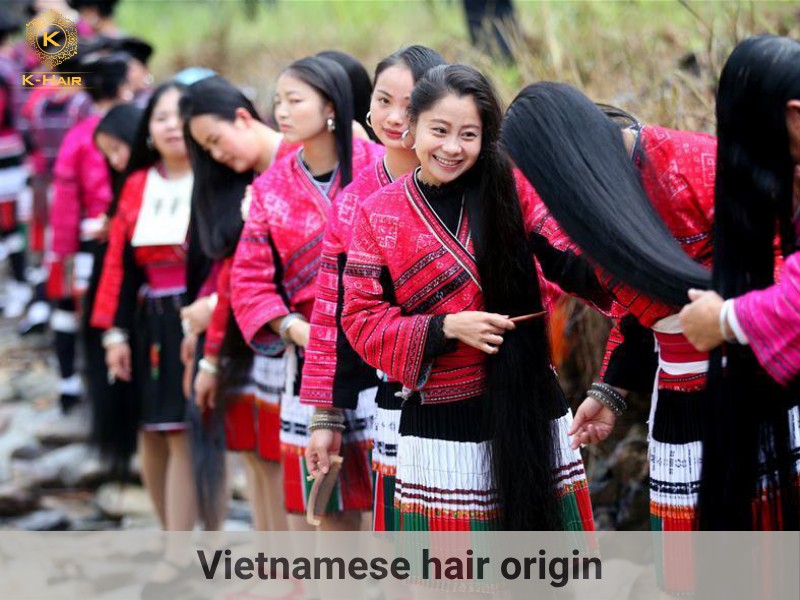
2. What is Indian hair?
Indian hair might have a more varied quality compared to Vietnamese hair. In reality, Indian hair manufacturers often collect their hair from two main sources: Temple hair and Hair balls. Temple hair, much like its name, is collected from temples, after the temple-goers’ religious practices of cutting their hair as an offering in exchange for their good luck. This is also the main source of high quality hair seen in many Indian vendors.
However, the second hair source is to be wary of, as Hair ball, like its name, is mostly tangled, messy hair collected from bathrooms, sidewalks, trash, or other unhygienic locations. After being washed, this hair source will be detangled and combed to become the market-ready hair products. However, this hair source is highly undesirable, as it is collected from unsanitary, unidentifiable sources, the manufacturers could rarely guarantee the hair’s integrity and functionality.
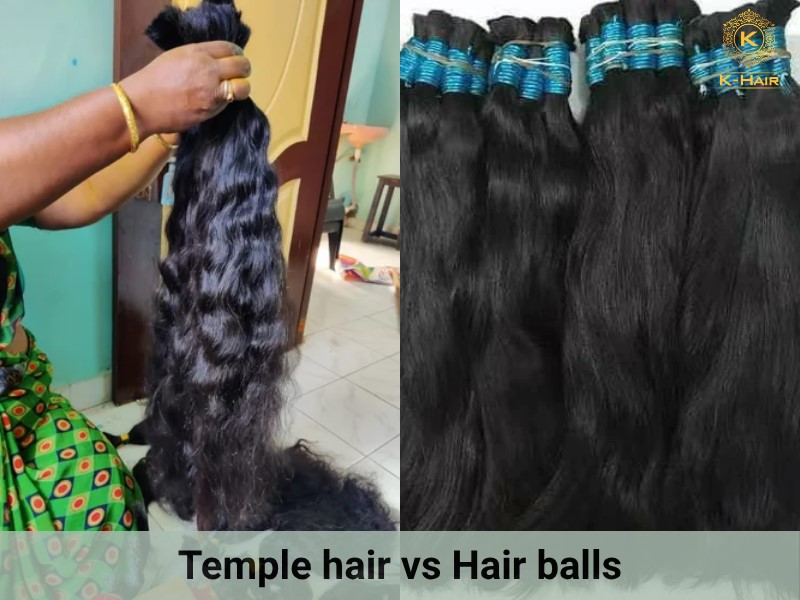
3. What are the differences between Vietnamese vs Indian hair?
Both Vietnamese and Indian hair are collected from two Asian countries with the richest hair sources in the globe. Hence, they can still possess in common some of the Asian hair’s signature traits such as natural black colors and desirable longevity. However, between the two hair lines, the number of differences clearly outweighs which of their similarities, especially based on the hair origin, features, and their manufacturers.
3.1. Hair features
Vietnamese hair is specifically praised as the World’s Finest hair for its physical appeal and versatility. These features are strictly available only in this unique hair line, as they are a combination of many desirable and exotic traits of its environment. For example, the country’s tropical monsoon climate, especially the colder weather in the north, provides the perfect temperature creating the hair’s soft, straight, thick strands. The local all-natural hair care, together with their balanced diet bring the needed nutrients to nurture the hair. These traits, together with the people’s signature genetic characteristics are the reasons for the hair’s soft, silky, smooth appeal, with minimum tangling and shedding. Due to its impressive quality, Vietnamese hair is well-known for its versatility and multi-functionality. In fact, in the hands of stylists, Vietnamese hair can allow repetitive styling without taking damage, and high-quality Vietnamese hair can even be bleached to as bright of color as #613.
Indian hair however, is inferior in terms of quality. The signature Indian hair is considered thin, coarse, with natural curls, as an adaptation to the country’s hot, dry climate. In fact, such thin, curly strands could be considered a special genetic feature seen in residents in dry areas, as it can help to ventilate temperature and ease the constant high heat. This also makes Indian hair harder to style and control, as its natural curls are extremely hard to straighten and must be chemically-processed to have a permanent result. Furthermore, the signature thin, coarse strands are considerably inflexible, causing potential breaking or shedding if undergone repeated styling or bleaching, making Indian hair extremely limited in terms of functionality, even the regular styling methods can cause the hair to take serious damage and deteriorate.
Moreover, low-quality hair products sourced from Hair balls can cause negative user experience with its undesirable features. Being collected from multiple sources also means that the hair cannot guarantee cuticle alignment and integrity. Hence, Indian hair from Hair balls are much easier to tangle and shed. Furthermore, upon being bleached, poor-quality Hair balls’ products cannot produce even colors like the standard Vietnamese hair.

3.2. Their manufacturer’s resources
The Vietnamese hair industry is the second-oldest among the other international options, with decades of experience in operating. Due to such a rich history in the business, they have successfully established a prestigious, trustworthy vendor image, attracting a vast number of customers worldwide. Such a long operating time in the industry also allows them to possess a skilled, experienced labour force, with specialized techniques to further ensure the overall product quality and uniformity. In fact, Vietnamese hand-tied closures are famous for their signature small knots, helping the hair piece to blend in better with the user’s natural scalp.
Their common business scale is household scale and factory scale, with both advanced technologies and skilled labour, facilitating large-scale production without risking the product’s uniformed quality.
The Indian hair industry, despite its huge advantage in large availability, is extremely obsolete in terms of resources and facilities. In fact, being the new-comer of the industry, the Indian hair labour force is still highly inexperienced with limited product knowledge and hair treatment techniques. Furthermore, due to their new age in the industry, as well as the country’s developing economy, their facilities are mostly old-fashioned, with most of their hair supply being dealt and treated by hand, or gone through harmful chemical-based processes to become market-ready products. This can not only tarnish the quality of the hair, but also restraint the overall productivity of the chain. Furthermore, their obsolete manufacturing methods and lack of business experience also limit their product range. In fact, most Indian hair vendors could only provide simple, natural textures and colors, instead of trendy ones, failing to satisfy a large number of fashion-focused hair buyers.
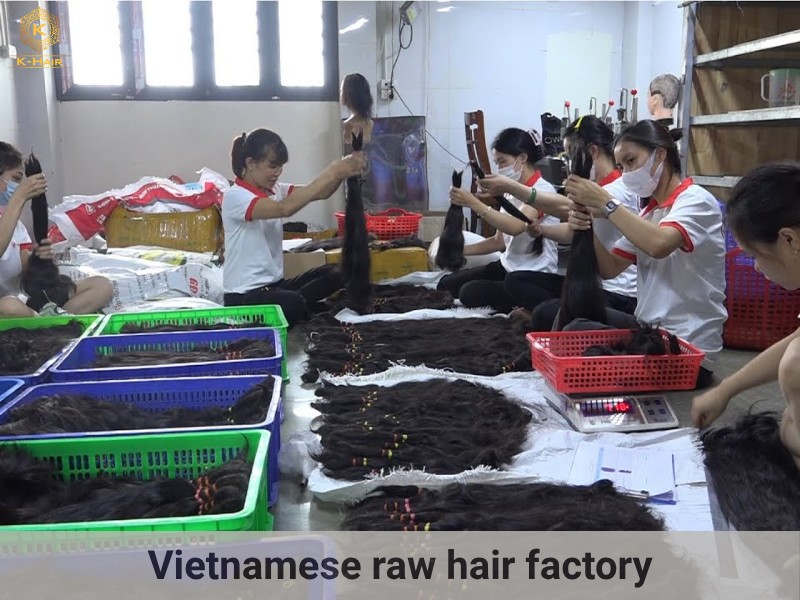
4. Which is the more suitable option for your business?
Both Vietnamese hair and Indian hair have their own signature characteristics, making them easy to tell apart. However, knowing their differences is just the first step, as business owners need to take careful consideration of their perks and drawbacks, in order to make the wisest decision for their brand.
| Features | Vietnamese Hair | Indian Hair |
| Origin |
|
|
| Versatility |
|
|
| Price | Reasonable factory-direct prices | Slightly lower than Vietnamese hair prices. |
| Product Range | More textures and colors available, satisfying trend-conscious hair buyers | Limited textures and colors, available only simple textures like straight, natural curly,… |
| Durability | Lifespan of 3-5 years and more | Lifespan of 1-2 years |
With its features, it is clear that Vietnamese hair caters to a wide range of customers whose focus is placed on quality and long-term use. Such desirable characteristics make Vietnamese hair suitable for hair brands aiming for luxurious images, or strict buyers with high demands for their products. On the other hand, Indian hair is best for short-term uses, suitable for budget-conscious hair buyers who want natural hair textures with the most affordable price possible for their business.
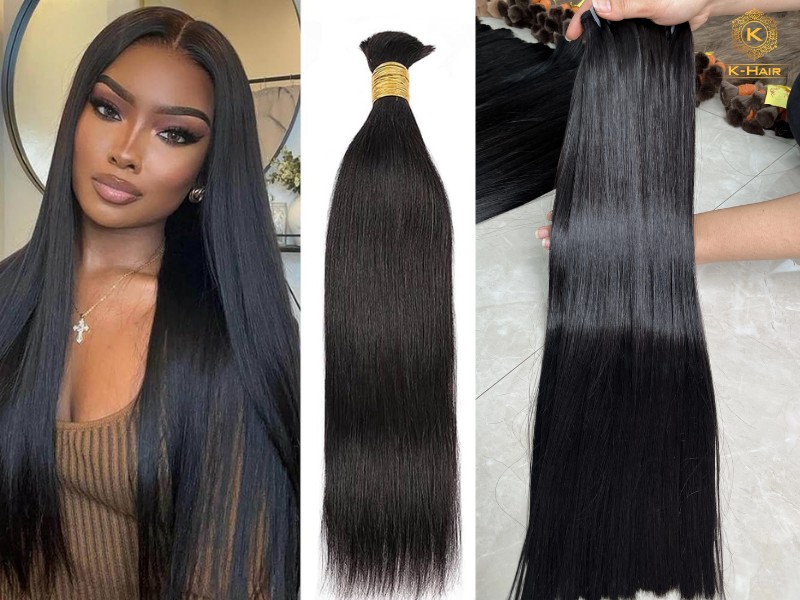
5. Top 7+ Best hair vendors for you business
If you’re looking for the best wholesale hair distributors for both Vietnamese and Indian hair, here are the most reliable options on the market:
5.1. K-Hair
With over 30 years of experience, K-Hair is one of Vietnam’s most well-established and globally recognized hair suppliers. As a pioneer in exporting Vietnamese hair, K-Hair has built a reputation for premium-quality hair extensions, including wefts, closures, wigs, and other product lines. Their raw materials are sourced from healthy Vietnamese donors, combined with traditional skills and craftsmanship and modern facilities to the most durable, smooth, and tangle-free products to the market. K-Hair is also known for their strong customer support, transparent pricing, attracting a large customer base worldwide.
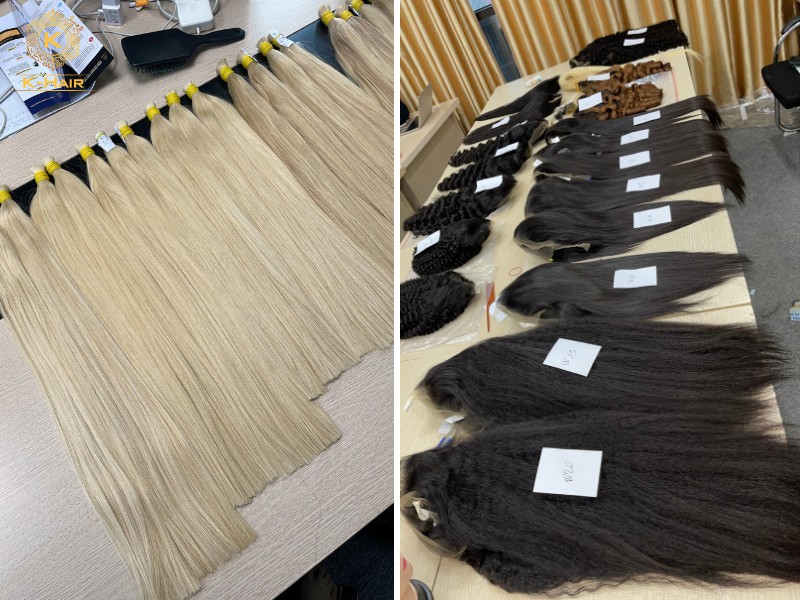
Contact For More Information:
- Website: https://khairvn.com/
- Address: 10A, 171 Nguyen Ngoc Vu, Cau Giay, Hanoi, Vietnam
- Phone: +8492 633 2545 (WhatsApp)
- Email: [email protected]
- Facebook: https://www.facebook.com/KHairFactoryVN/
- Youtube: https://www.youtube.com/c/KHAIRFACTORYBESTVIETNAMHAIR
- Whatsapp: +8492 633 2545
5.2. 5S Hair
5S Hair is a fast-growing Vietnamese hair manufacturer known for its commitment in providing 100% human hair products at factory-direct pricing. Located in the Northern regions – where with the most high-quality hair, 5S Hair takes full control of their supply and manufacturing, from sourcing to production, ensuring consistent quality and transparency for B2B clients. Their hair is highly favored for its natural softness, healthy shine, and long-lasting strength, making it especially popular among wholesale buyers across the globe.
What is so outstanding about them is their thorough, on-the-spot customer service, customization, which help them build a strong foundation for collaboration with resellers and distributors globally. Whether clients are looking for bulk hair, wigs, closures, or colored extensions, 5S Hair delivers both reliability and affordability in every transaction.
Contact For More Information:
- Address: Floor 5, 169 Nguyen Ngoc Vu Street Building, Cau Giay, Hanoi, Vietnam
- Hotline: +84 85 – 555 – 5348
- Email: [email protected]
- Website: 5shair.com
- Fanpage: www.facebook.com/5SHairOfficial
- Instagram: www.instagram.com/5s_hair_vietnam_offical/
- Youtube channel: https://www.youtube.com/@5SVietnameseHairFactory
5.3. Vin Hair
Vin Hair is another trusted Vietnamese hair vendor, specializing in premium Vietnamese virgin soft, thick, durable hair, meeting the Western and Latin market demands. With a wide product range including wefts, tape-ins, closures, frontals, Vin Hair provides clients with flexibility and order customization. Their large-scale factory also allows them to offer both affordable pricing and large product quantities, satisfying the rising demands for Vietnamese hair in the market.
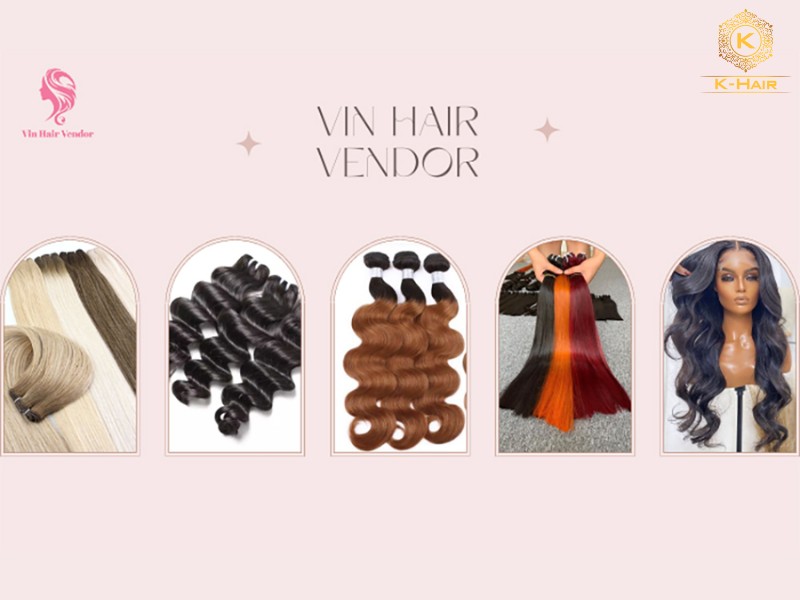
5.4. SGI Hair
SGI Hair is a leading Indian wholesale hair vendor with a strong international presence, focusing on Remy and Virgin hair products with reliable quality and cuticle alignment. Their wide product line includes bundles, closures, and wigs in natural and colored variations. Despite a relatively higher price range, their product quality has received a lot of positive feedback. Known for ethical sourcing, uniformed quality, and professional service, SGI Hair remains a popular choice for many hair businesses.
5.5. Chennai Hair Factory
Chennai Hair Factory is a well-known hair manufacturer based in Tamil Nadu, India, specializing in raw temple hair. They offer wefts, wigs, closures, and custom orders in bulk at competitive pricing. With authentic hair origin and in-house processing, they have been able to provide uniformity and consistency in their products.
5.6. Jaipur Hair
Jaipur Hair is a trusted Indian hair supplier offering 100% Remy and Virgin hair sourced directly from temples. Their focus on ethical sourcing and customization, as well as their diverse product lines including double drawn wefts, frontals, wigs are the reasons for their popularity. This, together with their competitive pricing and thorough customer support helps Jaipur Hair to attract a large number of customers worldwide, establish themselves as one of the most reliable Indian hair suppliers.
6. Vietnamese hair vs Indian hair Frequently Asked Questions
Vietnamese hair vs Indian Hair has always been a heated debate among the hair community, with many questions and concerns left unanswered. With our market knowledge, we have been able to provide explanations for some questions below:
6.1. Why do prices vary so much between vendors?
Prices are often determined by many factors like supply input, production, labour cost,… Due to the cheap, inexperienced labour and obsolete machinery, Indian hair buyers enjoy a lower product price and large availability. However, as quality comes with price, such low cost could already reflect its inferior versatility and durability. For Vietnamese hair, the price is higher because of the facility and production cost behind it. Nevertheless, Vietnamese hair prices are still considered reasonable, as the hands-on production and close proximity to the supply can cut down a great amount of additional costs and help to provide their high-quality product at factory-direct prices.
6.2. Which hair is better for African-American textured styles?
The answer is obviously Vietnamese hair, as it can offer more texture ranges, with many textures that resemble African-American women’s natural hair like Burmese curly, kinky straight, kinky curly,… Furthermore, the hair could also be restyled and bleached to please the diverse demands of buyers, without losing its natural durability. In fact, Vietnamese hair has been praised by its salon hair buyers to be able to hold curl for a much longer time, even after being washed, and be bleached to #613 with an even, desirable color outcome.
6.3. Can I dye or bleach Vietnamese/Indian hair?
Yes you can, especially for Vietnamese hair. In fact, Vietnamese hair can be bleached to as bright as #613 bright blonde, with an even color and well-preserved natural shine and softness. Indian hair could also be bleached, but only to a certain extent. In detail, Indian hair upon being bleached, can be severely damaged, due to the hair signature of weak, coarse, slightly-processed strands. Furthermore, hair products collected from Hair balls are extremely fragile, and cannot guarantee desirable dyeing and bleaching outcome.
7. Conclusion
With the information provided in this article, we hope that we have managed to assist young, ambitious business women in the hair industry about the contemporary trends, tips, and most importantly, the comparison of Vietnamese hair vs Indian hair. Doing business requires long-term commitment and support from trustworthy business partners, we proudly present ourselves not only as a trusted hair supplier, but also a supportive friend who will always have your back in this competitive industry.
Need to chat with a human hair specialist? Contact us through the following link:
- Website: https://khairvn.com/
- Address: 10A, 171 Nguyen Ngoc Vu, Cau Giay, Hanoi, Vietnam
- Phone: +8492 633 2545 (WhatsApp)
- Email: [email protected]
- Facebook: https://www.facebook.com/KHairFactoryVN/
- Youtube: https://www.youtube.com/c/KHAIRFACTORYBESTVIETNAMHAIR
- Whatsapp: +8492 633 2545

